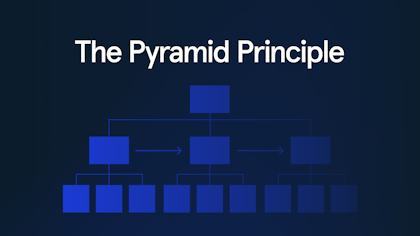At McKinsey, one of the lessons we learned was the importance of constructing compelling arguments. But persuasive communication is not only relevant for consultants, it's essential to most corporate jobs.
Yet, most people struggle with this.
This article presents a simple framework you can use to solve this issue and make your communication a lot more effective.
Picture this: It's Thursday afternoon, and you receive a message informing you that a 30-minute meeting with the CEO has been scheduled for TOMORROW so that you can present your strategy for the coming quarter.
You know every detail of the strategy, but the coherent, persuasive narrative you need to bring your CEO on board is still only a few unstructured notes.
Fear not; the Pyramid Principle comes to the rescue.
What is the Pyramid Principle?
The Pyramid Principle was developed by Barbara Minto during her more than ten years at McKinsey. While at McKinsey, Minto noticed that people, in general, were terrible at constructing compelling arguments. Their arguments lacked structure and focused too much on presenting data and facts upfront. As a result, by the time they reached their final recommendation, the audience had already lost interest or become distracted by the details.
Minto realized that unlike how you usually tell a good story, where you build suspense by delaying the resolution of a key issue until the very end, in a business presentation context you should do the exact opposite: Start with the answer.
Your colleagues or stakeholders don't need to be entertained; they're busy and want to get things done. So, the simple solution is to start with the answer.
This is what is known as the Pyramid Principle:
- Start with the recommendation/answer/solution upfront
- Back up that recommendation with a handful of supporting arguments
- Build trust in your arguments using supporting data
If you do this the structure of you argument ends up looking like a pyramid:
It's the exact opposite of what most of us are naturally drawn to — the upside-down-pyramid:
Most people, consciously or unconsciously, tend to use to the upside-down pyramid when presenting complex information. This is how we think and process information. We build up to a conclusion by first reciting all of the facts, recounting all of the analyses that have been done, or reviewing all of the supporting ideas. Then, we get to the punch line.
However, effective communication and thinking are not done in the same way. As Minto put it, "You think from the bottom up, but you present from the top down.".
Lead with the answer
At McKinsey, "lead with the answer" is drilled into every new hire. So, when an executive asks, "What should we do?", you should immediately respond with, "You should do X." Only after stating your conclusion should you delve into the reasons behind it.
Why is this approach effective?
- Time Efficiency: Executives are constantly pressed for time and appreciate brevity. They're accustomed to digesting information swiftly and can become restless if they feel you're beating around the bush. By leading with your recommendation, you respect their time. Sometimes, they might already align with your conclusion, so this method lets them agree and move on without needing a lengthy justification.
- Big Picture Thinking: Most executives prefer a "top-down" approach. They prioritize overarching strategies over minutiae. Presenting your conclusion upfront aligns with this mindset, letting them quickly grasp your main point.
- Persuasiveness: Directness conveys confidence. When you state your recommendation assertively from the start, it underscores your conviction, making you more persuasive. It ensures you appear decisive and straightforward.
Let's look at an example:
Before the Pyramid Principle
After the Pyramid Principle
Can you see the difference?
Suddenly, the ask is clear, and each following argument ties directly to it and strengthens it. The pitch is not only a lot more reader-friendly, but it's also way more persuasive and confident.
How to create effective presentations with the Pyramid Principle
When creating business presentations, "starting with the answer" translates to launching with a punch. Your initial slide should be a clear and well-structured Executive Summary, delivering the key takeaways, implications, or recommendations stemming from your analysis.
When you get into the details of your analysis, use the Pyramid Principle to lay out your proposed recommendation: answer first, followed by supporting arguments.
Final notes
If you're interested in learning more, check out the original book by Barbara Minto. At Slideworks, we have applied the Pyramid Principle across many of our most popular slide decks - e.g., our Business Strategy and Business Case templates.
We recommend that you try the Pyramid Principle when writing or presenting your next consulting proposal, strategy presentation, or pitch. We are confident that you will notice the difference.















